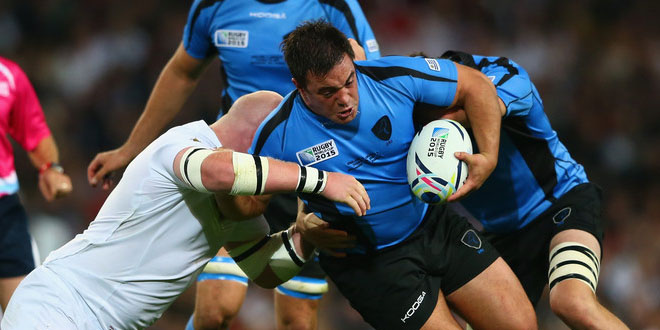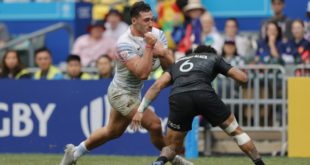A restructuring of the national selection, a new Head Coach for Los Teros and an enhanced role for the current Head Coach, Pablo Lemoine. These are some of the sweeping changes coming to the URU as part of a detailed plan to rise the level of the national team and ensure Uruguay compete in Japan 2019.
Looking to the future is not possible, as there is just not enough time. For Uruguay to capitalize on the ongoing growth action is required immediately and the URU is looking to do precisely this.
In an interview with Referí URU President Sebastián Piñeyrúa explained the changing times for Uruguay and the new dawn. Los Teros are set to have a calendar and playing conditions that players of the past dreamed of.
New Strategy
Between 7 and 10 Los Teros players are going to be contracted and a total of 24 annual matches divided between Los Teros and the Uruguay XV will prevent there from being a shortage of rugby for the players. The stated goal of the policy is for Uruguay to strengthen itself to be among the top 20 countries in the world.
Uruguayan rugby is charging the batteries for revolutionary changes in the coming four years. Los Teros’ World Cup campaign has been deemed a success by both the URU and World Rugby but both entities have determined that changes are necessary and urgent so that Uruguay can reach the elite.
New Structure
The URU desires for the High Performance Center at the Estadio Charrúa to become the training center for players. The aim being for players to be better prepared so that they can be as ready as possible for international duty and in the best condition possible, thereby facilitating the transition to the higher level.
Argentina is deemed to be a mirror in that the establishment of a firm structure and system gave rise to a current roster of 25 home-based players involved in the World Cup. Many of those went directly from the junior to the senior level.
In order for this to happen in Montevideo, there are going to be significant changes in personal. Pablo Lemoine will be relieved of duties as Head Coach to instead take on a new role as Director of the Development Center. As such, Lemoine will act as supervisor over the representative teams, the scouting of new talent in the mainland and the development of players at Charrúa. Lemoine has previously performed this role, sharing it with the duty of Head Coach.
Alliance with Argentina
With Lemoine no longer Head Coach the URU is seeking a foreign coach with the idea being to bring in an experienced Argentine, someone who has been involved with the PladAR program. Having begun in 2008 the program is considered a huge success and integral to Argentina’s Semi Finals finish at the World Cup.
For the time being there are various names being considered and the idea is to make an official announcement on December 15. The new Head Coach will assume the role with immediate effect, thereby coaching Los Teros on the Americas Rugby Cup opening weekend, where Uruguay will face Canada away on February 06 2016.
Working together with Argentina are having the UAR offering Piñeyrúa complete support is a vital component to the program succeeding. Piñeyrúa told Referí “we have to present World Rugby with a plan that demonstrated strong intentions to qualify for the next World Cup and we have planned an activity which is having a national team structure in place that is similar to that of the Tier 1.”
For this reason Lemoine and Piñeyrúa traveled to Los Angeles last week to participate in a World Rugby meeting featuring unions ranked 10th-20th in World Rankings. Countries were presented plans for the coming four years.
Professional Rugby
Additional changes are to see the URU, starting in 2016, having between 7 and 10 professional players. Those contracted are to be the backbone of Los Teros, of whom are based in Uruguay. They will be available at all times for international duty proving Uruguay with, together with those playing professional rugby abroad, between 12 and 15 professional or semi-professional players.
Such players would be fully ready and prepared to take to the field fully prepared to face the likes of Japan, Samoa, Tonga and the USA.
Competing against the Best
An additional breakthrough is that of regular international competition. The dark period of 2004-2012 was a period in which Los Teros struggled to play regularly with few opportunities of playing outside the South American Championship.
Starting in 2016 Los Teros will have 12 test matches a year. These matches are to be Tier 2 level and will begin with the Americas Rugby Cup which Uruguay’s 2016 calendar is already confirmed. Uruguay will play Canada, Brazil and Chile away in February while hosting Argentina and the USA in February and March.
Three additional test matches will see Uruguay playing in the Nations Cup, as has occurred in recent years. The competition will continue to be played in June with Montevideo penciled in as hosting the event in 2017. Los Teros’ remaining fixtures will come in the form of a three or more test series every November.
Over the 2016-2018 period Uruguay will play tests against Tier 2 countries in the November window, thereby giving Los Teros an annual total of 12 or more test matches. The country’s ‘A’ team, the Uruguay XV is to also play 12 or more matches.
Plans for Los Teros
Exactly who the 12 test match opponents will be is to become known in February. What has been confirmed is that the matches in November are to all be against Tier 2 unions and will take place in Europe.
The Uruguay XV will replace Los Teros in the South American Championship where a total of four matches are to be played. Five others will be in the Argentine Provincial Championship which the Uruguay XV competed in recently, finishing second in Zone B of the Promotional Division. The remaining fixtures will be against ‘A’ sides from Tier 2 countries. For 2016 the Fiji Warriors are expected to return.
Presenting Plan to World Rugby
On January 14-15 the URU will present their plans for the coming four years to World Rugby. With Uruguay being deemed Tier 2 rather than Tier 3 the union will be eligible for £300,000, a substantial rise from the Tier 3 annual funding budget of £90,000.
Convincing World Rugby that Los Teros mean business is the central factor in reaching Tier 2 category. It, in essence, means proving that Uruguay truly intends on playing at Rugby World Cup 2019. Doing this will require dedicated to the goal of improved infrastructure and investment in players, to resemble the Tier 1 model.
The Importance of Clubs
Piñeyrúa underlined the importance of Uruguayan clubs to the cause. “The project will not be possible without being fed by the URU club structure. The base of the pyramid that has Los Teros at the top is the clubs. This is important because clubs are continually producing better players and they are better prepared in all aspects.”
 Americas Rugby News Rugby news from across the Americas!
Americas Rugby News Rugby news from across the Americas!




